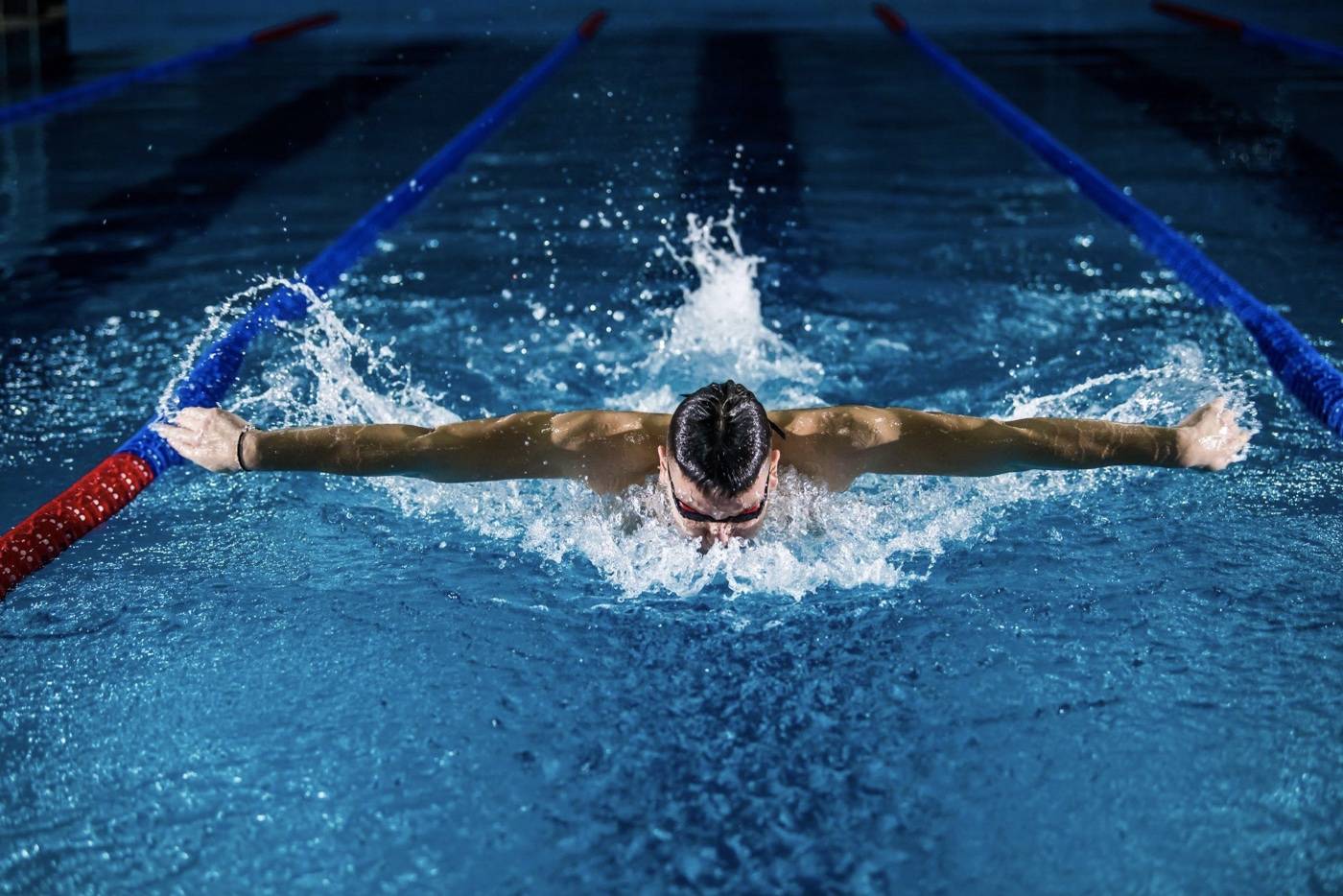Learn about the many health benefits of swimming, including increased strength and endurance, a healthy heart and immune system, and less stress.

June 2022. This article is independently written by Shelby Golding. All opinions given are hers. Shelby has been certified as a personal trainer and nutritional specialist since 2007. In 2008, she found her passion for writing about these topics and hasn't looked back.

Swimming is one of the most popular and effective types of cardiovascular activity. If you're trying to lose weight, it can burn 40% more calories than biking and 30% more calories than running per hour. The health benefits of swimming affect the whole body, from the muscles and bones to the heart and lungs. Swimming in saltwater even has benefits on the cellular level, promoting new cell growth and detoxifying the skin.
7 Health Benefits of Swimming and Water Workouts
Keep reading to learn about the health benefits of swimming and water workouts, from the physical to the mental and emotional.
1. Low-Impact Cardio
Swimming is recommended for anyone with chronic pain or inflammation because it's a low-impact type of cardio. For those with arthritis, swimming can reduce joint stiffness and pain while stimulating blood circulation and oxygen delivery throughout the body. In addition, it takes the weight off the muscles, joints, tendons, and ligaments to build strength in the muscles with a lower risk of injury and pain.
2. Builds Endurance
Swimming not only creates strong muscles but also builds endurance. It gets your heart pumping, strengthens your lungs, and boosts circulation. Over time, exercising to improve endurance will increase muscle coordination and balance.
As you grow older, endurance naturally declines because the body doesn't use oxygen as effectively. Swimming can help you maintain endurance as you age and may even slow down the aging process.
As you grow older, endurance naturally declines because the body doesn't use oxygen as effectively. Swimming can help you maintain endurance as you age and may even slow down the aging process.
3. Increases Muscle Strength
Muscle strength is essential for health, and swimming is one of the best forms of total body exercise to hit all your major muscle groups. It engages the large muscles in the core, arms, legs, back, and glutes. Depending on which stroke you choose, swimming targets different muscle groups so you can train (or avoid) certain ones if you need to. It even engages many smaller supporting muscles that are difficult to target by weight training or running.
4. Supports a Healthy Heart
Swimming is an aerobic exercise that supports a healthy heart. Long periods of aerobic exercise increase the heart's size and efficiency. The heart will pump more blood per minute, and blood flow will increase throughout the body. Thus, swimming reduces blood pressure and heart rate while it increases circulation.
5. Reduces Inflammation
Most experts agree that regular exercise helps the body fight against inflammation by increasing circulation and boosting the immune system. The body removes inflammatory substances from the body via the circulatory system and lymphatic system.
Too much waste build-up may eventually result in chronic inflammation, leading to illness or disease. But when both systems run smoothly, waste does not accumulate in the body.
Too much waste build-up may eventually result in chronic inflammation, leading to illness or disease. But when both systems run smoothly, waste does not accumulate in the body.
6. Improves Immunity
Most people don't understand the importance of a healthy lymphatic system for immune health. White blood cells move through the lymph system, identifying and removing harmful bacteria and viruses from the body.
If lymph fluid becomes stagnant, it can cause swelling and a compromised immune response. Swimming helps keep the lymphatic system healthy by promoting the movement of lymph fluid through the body. However, remember that too much exercise without adequate recovery can compromise the immune system by putting excessive strain on all of the body's systems.
If lymph fluid becomes stagnant, it can cause swelling and a compromised immune response. Swimming helps keep the lymphatic system healthy by promoting the movement of lymph fluid through the body. However, remember that too much exercise without adequate recovery can compromise the immune system by putting excessive strain on all of the body's systems.
7. Relieves Stress

Swimming releases endorphins, the body's feel-happy hormones, which reduce stress and increases happiness and well-being. A half-hour of swimming is enough to decrease incidences of anxiety and depression.
In addition to releasing endorphins, swimming also protects nerve cells in the brain and promotes nerve cell growth. Nerve cell health is especially important as we age since they play a crucial role in cognitive function and memory. In addition, nerve cell degeneration eventually leads to neurodegenerative diseases such as Alzheimer's and dementia.
In addition to releasing endorphins, swimming also protects nerve cells in the brain and promotes nerve cell growth. Nerve cell health is especially important as we age since they play a crucial role in cognitive function and memory. In addition, nerve cell degeneration eventually leads to neurodegenerative diseases such as Alzheimer's and dementia.
Types of Water Workouts
Doing laps in a pool is not the only type of water workout, but it is the most common and accessible. If you have an upper-body injury, you can even swim laps using a body board to focus all your efforts on the lower body.
You may want to experiment with different strokes depending on your fitness goals and limitations.
Breaststroke is an excellent combination of strength training and cardio. It primarily works the shoulders, chest, and lat muscles.
Freestyle is the most difficult to learn and do well. But once you master the correct technique, you are propelled through the water quickly and efficiently. It primarily works the chest, lat, and back muscles.
Backstroke is the best for recovery after your workout. It primarily works the back and lat muscles.
You may want to experiment with different strokes depending on your fitness goals and limitations.
Breaststroke is an excellent combination of strength training and cardio. It primarily works the shoulders, chest, and lat muscles.
Freestyle is the most difficult to learn and do well. But once you master the correct technique, you are propelled through the water quickly and efficiently. It primarily works the chest, lat, and back muscles.
Backstroke is the best for recovery after your workout. It primarily works the back and lat muscles.
The butterfly is the best for burning fat and boosting your metabolism. It primarily works your chest, back, core, and shoulders.
If you're interested in trying a water workout other than swimming laps, you might consider water walking, water jogging, or water aerobics.
Water walking and jogging are exactly how they sound. You walk or jog through the water, which provides resistance and helps build strength. Start slowly and gradually increase the duration as you grow stronger.
You may also want to try water aerobics. Most people take a class to learn the moves, but the concept is the same as an on-land aerobics class. Water aerobics exercises the entire body, including the arms, legs, and abs.
Try Swimming for Yourself!
Some people are intimidated to try a new type of exercise, but the health benefits of swimming make it worth the effort. Swimming is easy to learn and available in many fitness centers across the country. In addition, classes to learn how to swim are available for adults and children. Build strength and endurance, boost immunity, reduce stress, and find lasting health by making swimming part of your fitness routine.
And if you’re worried about swimming because of chronic pain, don’t be. The Kailo pain patch is waterproof and can come into the pool with you! Just apply it near the site of pain, as Kailo is designed to provide instant pain relief. A recent clinical study showed that 97% of users were extremely satisfied with Kailo over oral medication – the study also showed that 99% of patients felt pain relief with Kailo within 10 minutes of using the patch.
Disclaimer: Kailo should not be used if you have a pacemaker or if you are pregnant. Always consult your doctor or health care professional before using Kailo.
Disclaimer: Kailo should not be used if you have a pacemaker or if you are pregnant. Always consult your doctor or health care professional before using Kailo.






